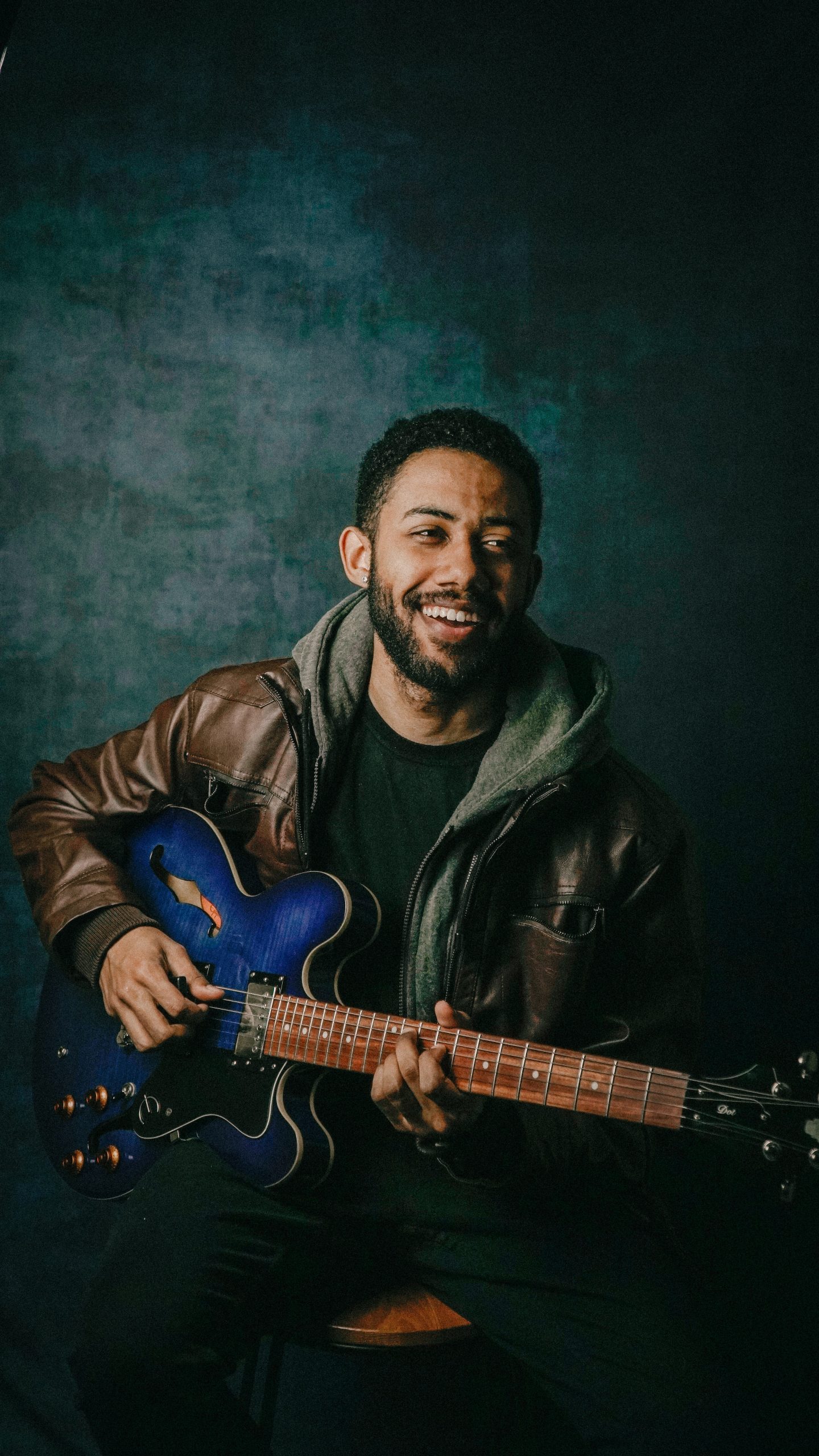The goal of this blog post is to provide a comprehensive guide on how guitarists play without looking at their instrument. Through a combination of understanding the layout, building muscle memory, ear training, and effective practicing techniques, it is possible to achieve this seemingly magical feat.
Playing the guitar without looking at it seems like a magic trick to many aspiring musicians. However, with the right techniques, practice, and a little bit of patience, it’s an achievable goal.
In this guide, we’ll demystify the process and provide a roadmap for guitarists of all levels to develop this impressive skill.
We’ll explore the layout of the guitar, discuss the concept of muscle memory, delve into the role of ear training, and share effective practicing techniques.
We’ll also provide real-life examples of guitarists who’ve mastered this skill, and offer useful tips and tricks to help you on your journey.
So let’s get started, and remember, every great guitarist was once a beginner.
Studies About How Guitarists Play Without Looking
The time it takes to play guitar without looking varies greatly depending on several factors, including the individual’s previous experience with the instrument, the amount of practice they put in, and their natural aptitude for music.
On average, it can take anywhere from six months to several years to reach a point where you can comfortably play without looking at your fingers.
For instance, a study published in the Journal of Neuroscience found that with consistent practice, guitarists can develop an internal map of the fretboard in their brains.
This map allows them to know where their fingers are and what notes they’re playing without needing to look at the guitar.
Moreover, Fender Play, a popular online guitar learning platform, states that it takes an average of 18 months for students to feel confident playing the guitar without constantly looking at it.
Ultimately, the key to mastering the guitar and playing without looking is consistent and focused practice.
As Guitar World concludes, “The more you learn and play, the less you need to look at your fingers.”
Understanding the Guitar Layout
The guitar layout is the first step towards mastering the art of playing without looking. Familiarity with your instrument is key.
Begin by understanding the guitar neck, which is divided into thin strips known as “frets”. These frets are the home for different notes, and together they form what we call the “fretboard”.
A typical guitar has six strings, each corresponding to a specific note: E, A, D, G, B, and E from the thickest to the thinnest.
Every note on the guitar is within reach on the fretboard – understanding where each note lies is crucial. This involves learning the ‘guitar fretboard map’.
This map guides you on where to find each note on every string, across all frets. Imagine it as a grid, each cell holding a unique sound.
Finally, understanding the shapes of scales and chords forms the groundwork for your journey. Scales are a series of musical notes played in ascending or descending order, while chords are a group of notes played together.
Mastering these shapes gives you the freedom to navigate the fretboard with ease.
Together, these elements form the layout of the guitar, and understanding them is the first crucial step towards playing the guitar without needing to look at it.
Muscle Memory and Guitar Playing
Muscle memory plays an integral role in achieving the ability to play guitar without looking. Essentially, muscle memory refers to the phenomenon where physical actions become automatic after repeated practice.
In the context of guitar playing, muscle memory helps your fingers instinctively find their way around the fretboard, freeing you from the need to constantly look at where your fingers are positioned.
This automaticity is developed through consistent, deliberate practice. As you repeatedly play scales, chords, and songs, your fingers gradually learn to make the right movements.
The process is similar to learning to type on a keyboard, where with enough practice, you no longer need to look at the keys to accurately type words.
However, building muscle memory takes time and patience. It’s important to start slow, focusing on playing the right notes rather than playing quickly.
Gradually, your speed will increase naturally as your fingers become more accustomed to the different movements.
With time and consistent practice, muscle memory will allow you to play the guitar without needing to look, allowing you to focus more on your music’s emotion and delivery.
Remember, muscle memory isn’t just about your hands. It’s also about your posture, your grip on the guitar pick, and the positioning of your arm and shoulder.
All these elements come together to create a seamless, automatic performance. Ultimately, muscle memory is a vital tool for any guitarist aspiring to play without looking at their instrument.
The Role of Ear Training in Playing Guitar
Just as muscle memory assists your fingers to navigate the fretboard without looking, ear training equips your hearing to identify notes, chords, and scales purely by sound.
This skill is integral for guitarists aspiring to play without looking at their instrument.
Ear training involves developing your active listening skills to discern the subtleties of different notes and chords.
When you can identify what you’re playing by ear, you can significantly reduce your reliance on sight when playing.
This ability helps you anticipate the sound that each string and fret will produce before you even touch the guitar, further guiding your fingers to the right places on the fretboard.
There are numerous exercises that can help improve your listening skills.
These exercises may involve identifying intervals – the difference in pitch between two sounds, recognizing chord progressions, and replicating melodies by ear.
There are also a variety of apps and online tools available to assist with ear training exercises.
Developing your ear takes time, consistent practice, and patience, much like building muscle memory.
But the rewards are substantial, not only enabling you to play without looking but also enhancing your overall musicianship.
With a finely trained ear, you can improvise more effectively, transcribe songs more easily, and communicate more fluently with other musicians.
So, in your journey towards playing the guitar without looking, don’t forget to lend an ear to the music you’re making.
Practicing Techniques: How Guitarists Play Without Looking
To play the guitar without looking, diligent and strategic practice is key. Here are some techniques you can use to accelerate your progress:
1. Start with single notes: Begin with one note at a time. Play it repeatedly until you can do so without looking. Gradually add more notes one by one, ensuring you’re comfortable with each before moving on to the next.
2. Gradual Speeding: Start slowly and focus on accuracy before speed. Once you can play a sequence of notes accurately without looking, gradually speed up your playing.
3. Diversify your practice: To prevent your practice from becoming monotonous, mix it up. Vary your practice by including different types of music, chords, and scales.
4. Visualize the Fretboard: Even when you’re not playing, take time to visualize the fretboard. Imagine playing different chords and scales, and where each note is located. This mental practice can help reinforce your physical practice.
5. Practice in the dark: Practicing in a dimly lit room or with your eyes closed can force you to rely on your fingers and ears, rather than your eyes. This can be a very effective way to develop the ability to play without looking.
6. Record your practice sessions: Recording your practice sessions allows you to playback and listen for any mistakes or areas that need improvement. It also helps you track your progress over time.
Remember, progress may be slow at first, but with consistent and strategic practice, you’ll soon notice improvements.
Be patient with yourself and try to enjoy the journey as much as the destination.
Playing the guitar without looking is an impressive skill that requires time and dedication, but the payoff is worth the effort.
Real-Life Examples of How Guitarists Play Without Looking
There are countless examples of accomplished guitarists who have honed the skill of playing without looking at their guitars.
This ability is not only impressive but also a testament to their discipline, dedication, and countless hours of practice.
- Stevie Ray Vaughan: Renowned blues guitarist Stevie Ray Vaughan was known for his intense guitar playing. He would often close his eyes and lose himself in the music, playing complex riffs and solos without a glance at the fretboard. His performances are a stunning example of the intersection of muscle memory and ear training.
- Jimi Hendrix: Legendary musician Jimi Hendrix is another guitarist who frequently played without looking. Whether he was playing behind his back or with his teeth, Hendrix was adept at navigating the fretboard blindly. His performances were breathtaking, demonstrating how far guitar playing could be pushed and the incredible potential of muscle memory.
- Django Reinhardt: Django Reinhardt, a jazz guitarist of the 1930s and ’40s, provides a unique instance. After an injury left him with only two functioning fingers on his left hand, he relearned to play the guitar, often diving into intricate solos without looking at the fretboard. Reinhardt’s story is a testament to the power of practice and perseverance in overcoming the odds.
These are just a few examples of the many guitarists who have mastered the art of playing without looking.
Their performances are a reminder of what can be achieved with dedication and consistent practice.
Tips and Tricks: How Guitarists Play Without Looking
Mastering the skill to play guitar without looking is a challenge but achievable with the correct approach and a few handy tips.
Here are some additional strategies that could enhance your practice:
- Relax your hand: Stress or tension in your hand can make it more difficult to navigate the fretboard without looking. Practice relaxing your hand and maintaining a loose grip on the neck of the guitar.
- Use your other senses: Besides relying on your hearing, you can utilize your sense of touch to feel the strings and the fretboard. The tips of your fingers are very sensitive and can help you differentiate between the strings and frets.
- Understand the fretboard: Study the layout of the fretboard and understand where each note lies. Knowing the notes on each string at each fret without looking drastically increases your familiarity with the guitar.
- Use guide points: You can use certain frets or the guitar’s body as guide points to know where your hand is on the fretboard. For example, the 12th fret is usually marked with a double dot, which can serve as a handy reference point.
- Practice regularly: The key to mastering any skill is regular and consistent practice. Dedicate a portion of your practice time specifically to playing without looking.
- Start simple and gradually increase complexity: Begin with simple chords or melodies. As your confidence increases, move on to more complex sequences.
- Be patient: Progress can be slow initially, but with time and consistent practice, you’ll see improvements. Don’t rush the process; be patient with yourself.
- Seek feedback: If possible, have someone observe your practice or record yourself playing. Feedback can help you identify areas where you need improvement and monitor your progress over time.
By applying these tips and tricks, you’ll be well on your way to mastering the skill of playing the guitar without looking. Happy practicing!








